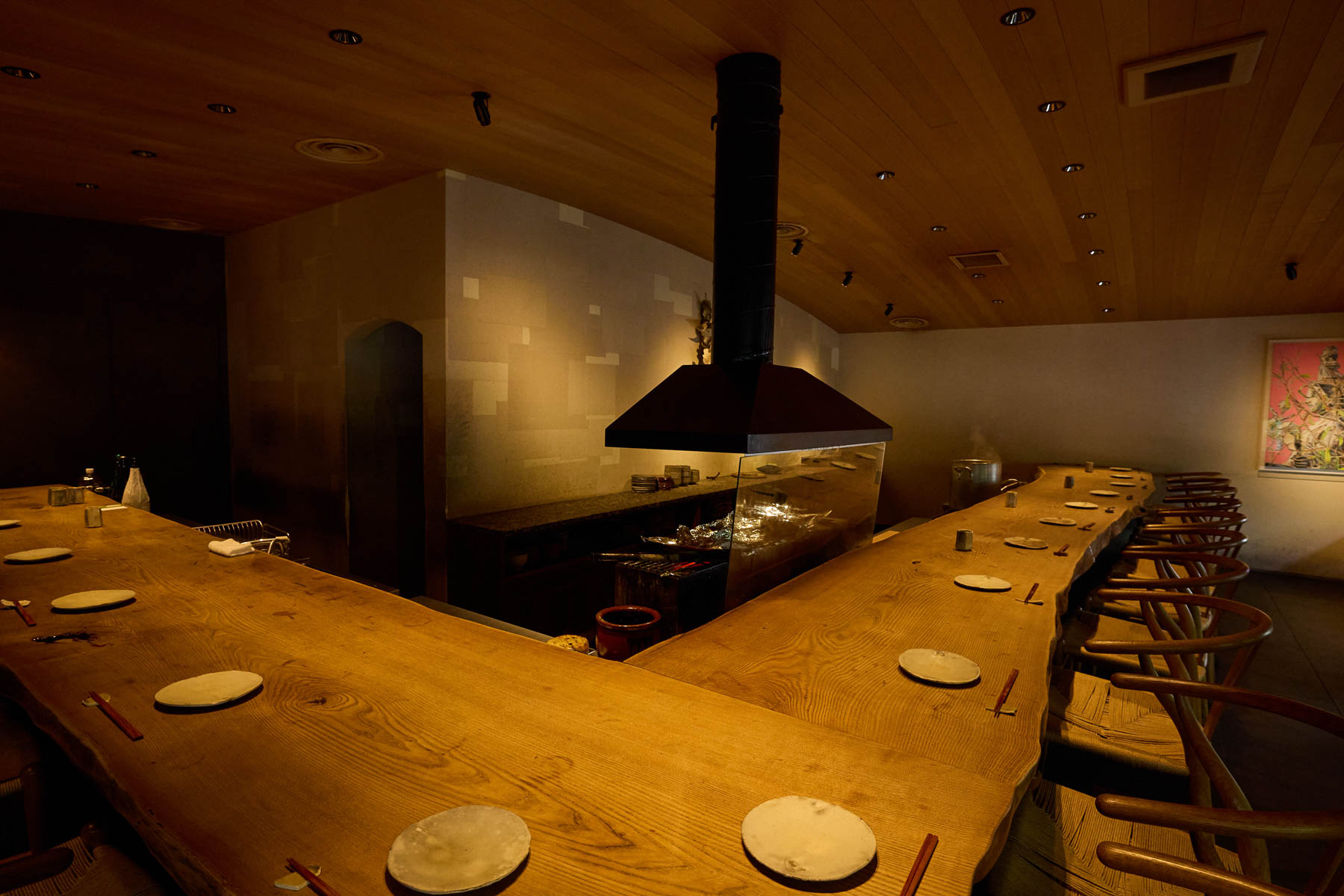
Osaka
Yakitori Goichi
吾一
Incredibly reasonable and unpretentious, you are guaranteed delicious yakitori and a good time at Osaka’s Goichi Higobashi. Every guest will find satisfaction in the chargrilled foods and free-flowing drinks served by a down-to-earth chef who loves art, sports, and, most importantly, barbecue.
In days gone by, Osaka was celebrated as the city of 808 bridges spanning the city’s many rivers, including Okawa, Dojimagawa, and Tosaborigawa. One such bridge is Higobashi, and while its form has changed many times, there are records of its existence from as early as the 17th century. Right by Higobashi in the heart of a bustling business district is Goichi, commanding attention with its black timber shopfront and solid copper door. Punctuated by lovely greenery, it is no surprise that the stylish modern shopfront draws many guests in. Inside you will find an L-shaped natural timber counter beneath an arc-shaped ceiling. Centerstage is the charcoal grill, so you can witness the cooking magic wherever you are seated. The movements of the nimble staff, the roasting aromas, the sizzling sounds – every sense is stimulated as you wait excitedly for each dish to arrive.
Chef Goichi Takeda is at the helm of a restaurant group expanding at an incredible clip now with eight stores in Osaka and the immediate surrounds. But the Higobashi location is the most popular because, as much as possible, Takeda does the chargrilling here. He has loved barbecuing from an early age and gets intense satisfaction from seeing the joy on the faces of people who taste his cuisine. It begins with quality ingredients in their freshest form. Still, from there, it is all about observing each item and employing techniques to maximise their innate fat, umami, and moisture content.
With two chargrills of different temperature levels, Takeda’s unique cooking style involves firing ingredients over the hotter one before resting them atop the slightly cooler one until returning to the hot one for a crisp finish. His methods involve different types of charcoals and skewering, as well as altering the distance from the heat source – techniques you can only master through years of experience. He keenly watches each item until they reach that perfect moment.
CUISINE
Incredibly reasonable and unpretentious
Expect to be treated to a satiating course of one or two vegetables, around twelve chicken dishes, a filling bowl of yakitori-don and soup when dining at Goichi Higobashi. Daily deliveries determine the precise composition, but the course features dishes using the whole chicken. It includes seared thigh meat, chicken meatballs and shiso-flavored meatballs, breast, heart, neck, breastbone cartilage (yagen nankotsu), tenderloin with pickled plum, charred duck, parson’s nose, kinkan immature eggs, and shishimaru – a sumptuous, salty, grilled bite of the precious portion from the chicken’s inner thigh. Takeda decides the order of service based on the depth of flavor, texture, and moisture content.
Goichi’s signature dish is called kimoni to tamahimo. It contains soft-braised fatty liver that melts in the mouth and the rich flavors of soft-boiled chicken oviduct with the immature egg. The barely cooked, seared thigh meat is local Tamba-dori chicken cooked over charcoals for crispy skin and juicy meat. It is served with green onions, salt, and grated ginger. Several dishes like skewered grilled thigh meat and the meatballs infused with shiso perilla leaves are served with hot Japanese mustard and wasabi to season to your liking. These are interspersed with delectable vegetable dishes, like a thick round of Senshyu onion full of tender sweetness and charred flavor. And then there is the fluffy, melt-in-the-mouth goodness of Fuwatoro Naganasu eggplant: grilled whole with the skin peeled just before serving, the texture and flavor experience is an incredibly pleasurable first for most guests.
The course comes to a close with a satisfying deep bowl of rice topped with grilled Tamba-dori thigh meat, a bright orange egg yolk, and lots of green onions, and served with soup whose flavor tells you the chef has used every chicken bone steeped for hours to extract this rich broth. The course can be enjoyed with free-flowing beer, sake, and whisky highballs. And for those who prefer wine, the chef invites you to venture into the cellar to make your own selection.
INGREDIENTS
The chicken used at Goichi is only wakadori young chicken ready for consumption after around eight weeks from hatching. Takeda’s is the freshest and best to be found through trusted suppliers. While jidori pedigree chicken is prized as a luxury ingredient, the choice of wakadori means Takeda can serve a delicious range of chicken parts at an affordable price, allowing guests to eat to their hearts’ content. Beer, sake, shochu, and highballs are all free flowing, meaning no surprises for guests when the bill arrives. It also makes it easier to split bills, which is very common these days. Takeda’s style choices are all about comfort and enjoyment for his guests.


CHEF
Goichi Takeda
VEGETABLES
The chef takes pride in the deeply satisfying vegetables that cannot be found elsewhere. One Osaka specialty vegetable is Senshyu yellow onions from Iteya Farm; some are as big as a baby's head. Super sweet and dense, the heat from the charcoals makes them irresistibly soft and delicious and makes you keep coming back for more. Another is jumbo eggplant called Fuwatoronaganasu, as large as five centimetres wide and 35 centimetres long. The thick, shiny skin softens and melts away after grilling to reveal sweet and juicy flavours that eat like a palate cleanser when served between chicken courses.
Course
- The price includes our booking fee of ¥8,000
- The price includes our booking fee of ¥8,000
- The price includes our booking fee of ¥8,000
- The price includes our booking fee of ¥8,000












